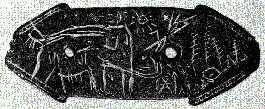
Links to a discussion originally appended to another article--Comet Trails...--from ~1988:

An 1885 book by H. C. Mercer that investigates the authenticity of the carving on the above gorget.
An investigation of the root tap and words derived from it which may be associated with describing comets and impact events:
Accounts of small, apparent impact events, which caused a fire but little if any blast damage:
This observation taken from the writings of G.J.N. Wilson (The Early History of Jackson County Georgia, 1914, pp. 188-193, W.E. White editor) gives a remarkable account of a Native American Stonehenge-like construction as well as a description of the type conditions which prompted a gathering:
For those who enjoy a challenge:
An ongoing discussion of issues related to this broadening area of research:
David Milne's academic prize winning Essay on Comets, published by the University of Edinburgh in 1828:
The earliest known symbol, and its migration; with observations on the migration of certain industries in prehistoric times. By Thomas Wilson, (1894) Curator, Department of Prehistoric Anthropology, U.S. National Museum.
The Sibylline Oracles (Books III-V) as translated by H. N. Bate (1918):
A history of the Dragon in China and Japan, by M. W. de Visser (1913):
The She King, translated by James Legge (1876):
Ilios: City and Country of the Trojans, by Henry Schiliemann (1881):
In The Shadow Of The Bush, by P. Amaury Talbot (1912):
A discussion of the historicity of the Mahabharata, edited by S.P. Gupta and K.S. Ramachandran (1976):
An early (1882) discussion, by Ignatius Donnelly, of the possibility of Earth being hit by a comet:
The Channeled Scabland: A Guide to the Geomorphology of the Columbia Basin, Washington, by Victor R. Baker & Dag Nummedal, NASA (1978):